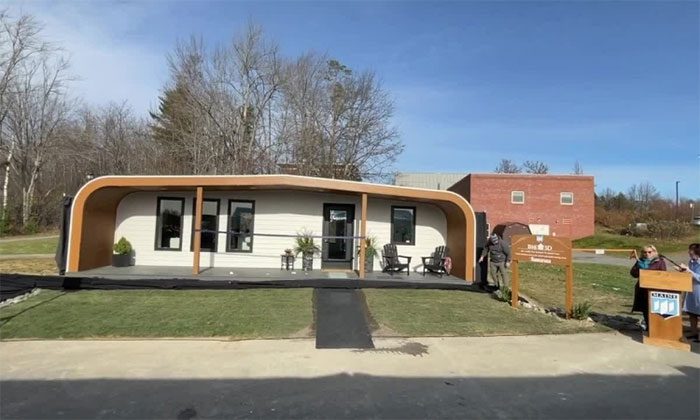A team of experts from the University of Maine has 3D printed a prototype house measuring 56m2 using materials such as wood and biodegradable plastics, which are fully recyclable.
The Advanced Structural and Composite Materials Center (ASCC) at the University of Maine has constructed BioHome3D – the world’s first 3D-printed house entirely made from biodegradable materials – in Orono, Maine, USA, as reported by Design Boom on January 7.
The wooden house is 3D printed layer by layer using an industrial polymer printer, resulting in minimal construction waste due to its highly precise printing process. The prototype, covering an area of 56m2, features 3D-printed floors, walls, and roofs made from wood fibers and biodegradable plastics. The house also offers excellent insulation with a 100% wood-based insulating layer and is fully recyclable.
Inside, the house provides a cozy atmosphere with wood tones covering most of the space. It includes a living room, kitchen, bedroom, and workspace. While the number of windows is limited, the interior lighting compensates for this.

The prototype house measuring 56m2 features 3D-printed floors, walls, and roofs made from wood fibers and biodegradable plastics.
BioHome3D is located near the ASCC center and is equipped with sensors to monitor its structure, environment, and temperature to assess the house’s condition in cold climate conditions. The data collected will help researchers refine the design and materials, leading to the development of homes that can adapt to future weather changes.
BioHome3D is also seen as a promising solution to the labor shortage and the increasingly severe housing crisis in Maine. The technology used in constructing the house addresses labor shortages and supply chain issues that drive up costs and limit the availability of affordable housing. According to the University of Maine experts, BioHome3D requires less time for construction and on-site assembly due to automated production taking place off-site.
With its printing materials being abundant, renewable wood fibers sourced locally, and advanced manufacturing processes and materials developed by ASCC, the reliance on unsustainable supply chains can be reduced, making affordable housing more accessible in the future while still meeting the needs and desires of homeowners.


















































